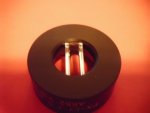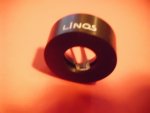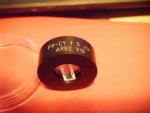- Joined
- Jul 10, 2015
- Messages
- 13,021
- Points
- 113
Yes and the emitter it's self is rectangular, so what goes into the concave cylindrical lens looks like l and the narrow side to side part is the fast expanding axis.
I just focus my horizontal line at 15 feet or infinity and then work at 15 feet to center the horizontal line, then the concave cyl expands that line from 2 inches to about 3 feet and it has to be centered and the lens tilt must align with the emitter as well as the lens rotation must be in alignment, " parallel to the emitter" as seen at a distance, then the 2nd lens the cyl convex is placed to set the least divergent beam as possible by moving fore and aft but must also be in 3 dimensional alignment. Like holding a magnifying glass under the sun it prints an image of the point source correctly when aligned on both axis.
But by working at 15 feet it's easier to get the alignment right, if attempted on a desktop your bar may look like a flag in the wind all bent and wavy when re examined at a longer distance.
The 7875 uses 2x or 3x and the 44 and 06 diodes use 6x that's not perfect but pretty good. If you want some try LSP or OPT, also I have seen some Chinese pairs on flebay but have not tested them yet.
I just focus my horizontal line at 15 feet or infinity and then work at 15 feet to center the horizontal line, then the concave cyl expands that line from 2 inches to about 3 feet and it has to be centered and the lens tilt must align with the emitter as well as the lens rotation must be in alignment, " parallel to the emitter" as seen at a distance, then the 2nd lens the cyl convex is placed to set the least divergent beam as possible by moving fore and aft but must also be in 3 dimensional alignment. Like holding a magnifying glass under the sun it prints an image of the point source correctly when aligned on both axis.
But by working at 15 feet it's easier to get the alignment right, if attempted on a desktop your bar may look like a flag in the wind all bent and wavy when re examined at a longer distance.
The 7875 uses 2x or 3x and the 44 and 06 diodes use 6x that's not perfect but pretty good. If you want some try LSP or OPT, also I have seen some Chinese pairs on flebay but have not tested them yet.
Last edited:







